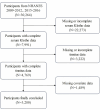Association of serum Klotho with tinnitus prevalence, duration and severity: A cross-sectional study in middle-aged and older adults
- PMID: 40737282
- PMCID: PMC12309988
- DOI: 10.1371/journal.pone.0327228
Association of serum Klotho with tinnitus prevalence, duration and severity: A cross-sectional study in middle-aged and older adults
Abstract
Background: As an anti-aging protein, although studies increasingly suggest that the Klotho plays a role in the auditory system, the link between serum Klotho levels and tinnitus remains poorly characterized. The aim of this study was to investigate the associations between serum Klotho levels and tinnitus focusing on prevalence, duration and severity in middle-aged and older adults.
Methods: We performed a population-based cross-sectional study of individuals in the National Health and Nutrition Examination Survey (NHANES) 2009-2012 and 2015-2016. Univariable and multivariable logistic regression was used to evaluate the relationship between serum Klotho levels and tinnitus, with adjustment for potential confounders and further age-stratified analyses. Restricted cubic splines were applied to assess potential non-linearity in the dose-response relationship. Furthermore, Subgroup and interaction analyses were conducted to assess the consistency of this association.
Results: In this research of 3280 individuals aged 40-79 years with a median age of 55 (IQR: 48, 62) and 48% male participants, the median serum Klotho level was 779.80pg/mL. Multivariable logistic regression uncovered consistent inverse associations between serum Klotho levels and tinnitus incidence across progressively adjusted models (ORs: 0.68-0.70, p = 0.009-0.01). Age-based stratified analyses suggested the strongest effect was observed in individuals aged 50-59 years (full model ORs: 0.55, p = 0.046). A marginally significant protective effect was observed in the 60-69 age group (unadjusted OR=0.62, 95% CI: 0.39-1.00, p = 0.050). Serum Klotho levels showed no significant correlation with tinnitus severity, while a potential association with the duration of tinnitus was observed (p = 0.058). Additionally, restricted cubic spline analysis revealed a linear inverse association between Klotho and tinnitus risk stratified by age (all p for nonlinear >0.15). Finally, subgroup and interaction analyses revealed no significant effect modification (all p-interaction >0.1).
Conclusion: Serum Klotho concentrations showed a consistent inverse association with tinnitus prevalence in US adults, with the strongest effect observed in individuals aged 50-69 years.
Copyright: © 2025 Du et al. This is an open access article distributed under the terms of the Creative Commons Attribution License, which permits unrestricted use, distribution, and reproduction in any medium, provided the original author and source are credited.
Conflict of interest statement
The authors have declared that no competing interests exist.
Figures



Similar articles
-
Maintaining ideal cardiovascular health is associated with higher serum anti-aging protein klotho in the middle-aged and older populations.J Nutr Health Aging. 2024 Jun;28(6):100224. doi: 10.1016/j.jnha.2024.100224. Epub 2024 Apr 5. J Nutr Health Aging. 2024. PMID: 38582034 Free PMC article.
-
The association of serum klotho with pulmonary function among US adults: a cross-sectional study.BMC Pulm Med. 2025 Jul 2;25(1):290. doi: 10.1186/s12890-025-03746-2. BMC Pulm Med. 2025. PMID: 40604699 Free PMC article.
-
Association of serum Klotho concentrations with abdominal obesity among middle-aged adults in the US: Evidence from NHANES 2011-2016.Nutrition. 2025 Aug;136:112809. doi: 10.1016/j.nut.2025.112809. Epub 2025 Apr 17. Nutrition. 2025. PMID: 40381255
-
Systemic pharmacological treatments for chronic plaque psoriasis: a network meta-analysis.Cochrane Database Syst Rev. 2021 Apr 19;4(4):CD011535. doi: 10.1002/14651858.CD011535.pub4. Cochrane Database Syst Rev. 2021. Update in: Cochrane Database Syst Rev. 2022 May 23;5:CD011535. doi: 10.1002/14651858.CD011535.pub5. PMID: 33871055 Free PMC article. Updated.
-
Effectiveness and safety of vitamin D in relation to bone health.Evid Rep Technol Assess (Full Rep). 2007 Aug;(158):1-235. Evid Rep Technol Assess (Full Rep). 2007. PMID: 18088161 Free PMC article.
References
-
- Chen J, Zou W, Li H, Luo Y, Lu K, Yi X, et al. Does tinnitus amplify the effects of healthy eating patterns and physical activity on the sleep disturbance or sleep insufficiency, based on the case study of NHANES survey in the United States. Front Nutr. 2024;11:1427672. doi: 10.3389/fnut.2024.1427672 - DOI - PMC - PubMed
-
- Baguley D, McFerran D, Hall D. Tinnitus. The Lancet. 2013;382(9904):1600–7. - PubMed
-
- Chen S, Yang X, Jiang Y, Wu F, Li Y, Qiu J, et al. Associations between physical activity, tinnitus, and tinnitus severity. Ear Hear. 2023. May;44(3):619–26. - PubMed
MeSH terms
Substances
LinkOut - more resources
Full Text Sources
Medical
Research Materials

